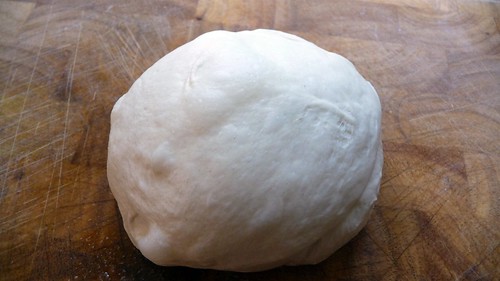For Christmas I purchased The Godfather trilogy on Blu-Ray for Bo. Last week, we set up our new BluRay player (ps it is august 1st). To celebrate, we have planned a Godfather weekend, complete with Italian food.
To kick it off, I made Pizza Napoletana Margherita from Peter Reinhart. I havent strayed from whole wheat pizza crust for many weeks, but was ready to try something different - and boy am I glad I did! This crust is easy to make, and has amazing flavor. I try so hard to only put whole grains in our bodies, but I may have to relax the rules for pizza nights!
This dough starts a day ahead of time mixing iced water with chilled flour, yeast and salt. After separating into balls, the dough is put into the refrigerator where is sits until ready to use. (Note: The rest of the balls have been put into the freezer for future use)
Last night I pulled the dough ball out of the fridge to let it come to room temperature. It had the perfect elasticity and was easy to work with, even cold.

Two hours later I started the shaping process, first pressing it into a round disk, then letting it rest before working on it again. When I felt it was the correct size, I covered it and left it to rest on the cornmeal covered peel while preheating the oven.

Just before baking I spread the crust with the evening's choice of ingredients. Wanting a simple pizza true to its Italian roots, we choose a simple tomato sauce from the freezer, a sprinkling of sea salt, a few slices of buffalo mozzarella and a handful of snipped basil. This was slid onto the hot baking stone and left to quickly bake. Five minutes later it was ready to be pulled back out for a very quick rest before being sliced and consumed.
We both loved this pizza, and both felt this crust may be our new favorite. Served with beer on our deck, it was a perfect Friday evening. Stay tuned for more Italian goodies...
Peter Reinhart's Napoletana Pizza Dough Recipe (Adapted from The Bread Baker's Apprentice)
4 1/2 cups (20.25 ounces) unbleached high-gluten,-- bread, or all-purpose flour, chilled
1 3/4 (.44 ounce) teaspoons salt
1 tsp (.11 ounce) instant yeast
1/4 cup (2 ounces) olive oil (optional) (I left this out)
1 3/4 cups (14 ounces) water, ice cold (40°F)
Semolina flour OR cornmeal for dusting
Stir together the flour, salt, and instant yeast in a 4-quart bowl (or in the bowl of an electric mixer). With a large metal spoon, stir in the oil and the cold water until the flour is all absorbed (or mix on low speed with the paddle attachment), If you are mixing by hand, repeatedly dip one of your hands or the metal spoon into cold water and use it, much like a dough hook, to work the dough vigorously into a smooth mass while rotating the bowl in a circular motion with the other hand. Reverse the circular motion a few times to develop the gluten further. Do this for 5 to 7 minutes, or until the dough is smooth and the ingredients are evenly distributed.
If you are using an electric mixer, switch to the dough hook and knead on medium speed for 5 to 7 minutes, or as long as it takes to create a smooth, sticky dough. The dough should clear the sides of the bowl but stick to the bottom of the bowl. If the dough is too wet and doesn't come off the sides of the bowl, sprinkle in some more flour just until it clears the sides. If it clears the bottom of the bowl, dribble in a tea- spoon or two of cold water. Let it rest 15 minutes, then knead another 1 minute. The finished dough will be springy, elastic, and sticky, not just tacky, and register 50 to 55F.
Sprinkle flour on the counter and transfer the dough to the counter. Prepare a sheet pan by lining it with baking parchment and misting the parchment with spray oil (or lightly oil the parchment). Using a metal dough scraper, cut the dough into 6 equal pieces (or larger if you are comfortable shaping large pizzas), You can dip the scraper into the water between cuts to keep the dough from sticking to it, Sprinkle flour over the dough. Make sure your hands are dry and then flour them. Lift each piece and gently round it into a ball. If the dough sticks to your hands, dip your hands into the flour again. Transfer the dough balls to the sheet pan, Mist the dough
generously with spray oil and slip the pan into a food-grade plastic bag.
Put the pan into the refrigerator overnight to rest the dough, or keep for up to 3 days. (Note: If you want to save some of the dough for future baking, you can store the dough balls in a zippered freezer bag. Dip each dough ball into a bowl that has a few tablespoons of oil in it, rolling the
dough in the oil, and then put each ball into a separate bag. You can place the bags into the freezer for up to 3 months. Transfer them to the refrigerator the day before you plan to make pizza.)
On the day you plan to make the pizza, remove the desired number of dough balls from the refrigerator 2 hours before making the pizza. Before letting the dough rest at room temperature for 2 hours, dust the counter with flour, and then mist the counter with spray oil. Place the dough balls on top of the floured counter and sprinkle them with flour; dust your hands with flour. Gently press the dough into flat disks about 1/2 inch thick and 5 inches in diameter. Sprinkle the dough with flour, mist it again with spray oil, and cover the dough loosely with plastic wrap or a food-grade plastic bag. Now let rest for 2 hours.
At least 45 minutes before making the pizza, place a baking stone either on the floor of the oven (for gas ovens), or on a rack in the lower third of the oven. Heat the oven as hot as possible, up to 800F (most home ovens will go only to 500 to 550F, but some will go higher). If you do not have a baking stone, you can use the back of a sheet pan, but do not preheat the pan.
Generously dust a peel or the back of a sheet pan with semolina flour or cornmeal. Make the pizzas one at a time. Dip your hands, including the backs of your hands and knuckles, in flour and lift 1 piece of dough by getting under it with a pastry scraper. Very gently lay the dough across your fists and carefully stretch it by bouncing the dough in a circular motion on your hands, carefully giving it a little stretch with each bounce. If it begins to stick to your hands, lay it down on the floured counter and reflour your hands, then continue shaping it. Once the dough has expanded outward, move to a full toss as shown on page 208. If you have trouble tossing the dough, or if the dough keeps springing back, let it rest for 5 to 20 minutes so the gluten can relax, and try again. You can also resort to using a rolling pin, though this isn't as effective as the toss method.
When the dough is stretched out to your satisfaction (about 9 to 12 inches in diameter for a 6-ounce piece of dough), lay it on the peel or pan, making sure there is enough semolina flour or cornmeal to allow it to slide. Lightly top it with sauce and then with your other top-pings, remembering that the best pizzas are topped with a less-is-more philosophy.
Slide the topped pizza onto the stone (or bake directly on the sheet pan) and close the door. Wait 2 minutes, then take a peek. If it needs to be rotated 180 degrees for even baking, do so. The pizza should take about 5 to 8 minutes to bake.
Remove the pizza from the oven and transfer to a cutting board. Wait 3 to 5 minutes before slicing and serving, to allow the cheese to set slightly.


No comments:
Post a Comment